By Xining Wang and Qifang
Microservices deliver various benefits such as scalability, agility, independent scaling, business logic isolation, independent lifecycle management, and easier distributed development. However, a large number of distributed microservices increase security risks because each microservice is an object that may be attacked. Kubernetes provides an excellent platform for managing and orchestrating your microservices. However, all interactions between microservices are not secure enough by default. They communicate over plain text HTTP, which is not enough to meet security requirements. It is not enough to rely on the network boundary to ensure security. Once an internal service is compromised, the boundary security method is easily broken through, which can be used as the springboard to attack the internal network. Therefore, internal calls must be secure, which is where zero trust comes into play.
Zero trust (proposed by Forrester analyst John Kindervag) means there is no implicit trust, whether inside or outside the network boundary. In other words, explicit authentication is required everywhere, and the principle of least privilege is used to control access to resources.
An important value of service mesh technology is that it can effectively protect the application's production environment without reducing developers' productivity. Through service mesh technology, it provides the necessary foundation for the microservice architecture to adopt a zero trust network security method to achieve the security goals of strong authentication, context-based authorization, record monitoring, etc. These mesh features can provide security control capabilities for all applications that belong to the mesh. For example, all traffic is encrypted, and all traffic to the application is verified by the policy enforcement point (PEP).
Alibaba Cloud Service Mesh has become one of the important carriers of landing cloud-native zero trust systems. It offloads authentication and authorization from application codes to the service mesh, which is out-of-the-box and dynamically configurable and makes the update strategy easier with immediate effect. In addition to using Kubernetes Network Policy to implement three-tier network security control, ASM provides peer identity authentication and request identity authentication, Istio authorization policies, and more refined OPA-based policy control capabilities. These zero trust security capabilities provided by ASM help users achieve the preceding security goals.
The theoretical system for building ASM capabilities includes the following aspects:
Compared with the traditional method of building security mechanisms directly in application code, the service mesh architecture has the following security benefits:
With ASM, you can use a single control panel to implement powerful identity and access management, transparent TLS and encryption, authentication and authorization, and audit log entry. ASM provides these features out of the box. The simplicity of installment and management allows developers, system administrators, and security teams to protect their microservice programs properly.
ASM reduces the attacks in the cloud-native environment and provides a basic framework for building a zero trust application network. Through ASM management service to service security, it ensures service mesh end-to-end encryption, service-level identity authentication, and fine-grained authorization policies.
Under the service mesh system, it can:
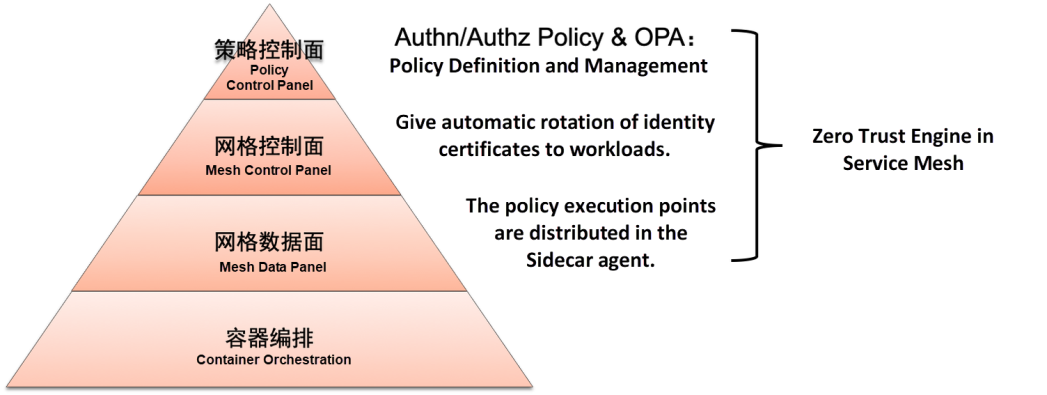
Currently, ASM provides the following basic zero trust security capabilities:
The service mesh assigns a unique identifier to each service when the program is running in the service mesh environment. This identifier is used when connecting to other microservices in the service mesh. The service identifier can be used for two-way service authentication to verify whether to allow access between services. It can also be used in authorization policies.
When using ASM to manage workloads running on Kubernetes or define virtual machine workloads based on WorkloadEntry, ASM provides a service identity for each workload. This identity is implemented based on the workload's service account token.
Service identities in ASM comply with the SPIFFE standard and have the following format:
spiffe://<trust-domain>/ns/<namespace>/sa/<service-account>In the ASM console, open the corresponding ASM instance. In the left-side navigation pane, you can view the following workload identity under zero trust security.
Workloads under the Kubernetes cluster in the data plane and their identity definitions:
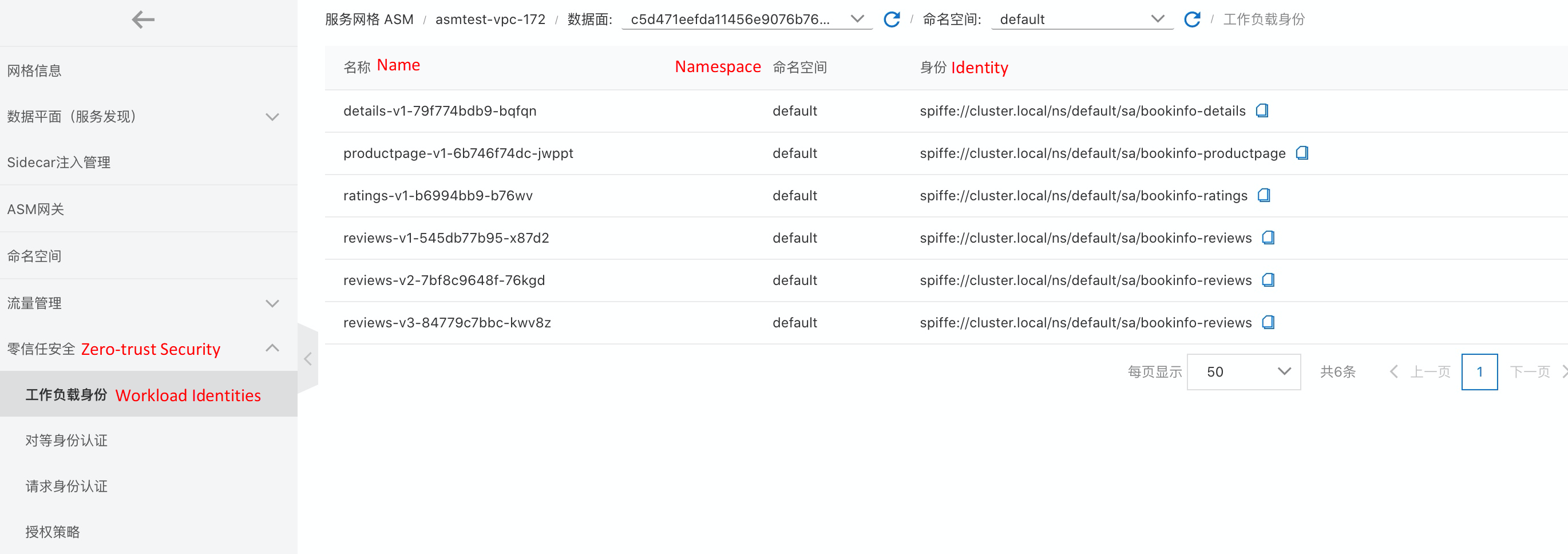
Define virtual machine workloads and their identities based on WorkloadEntry:
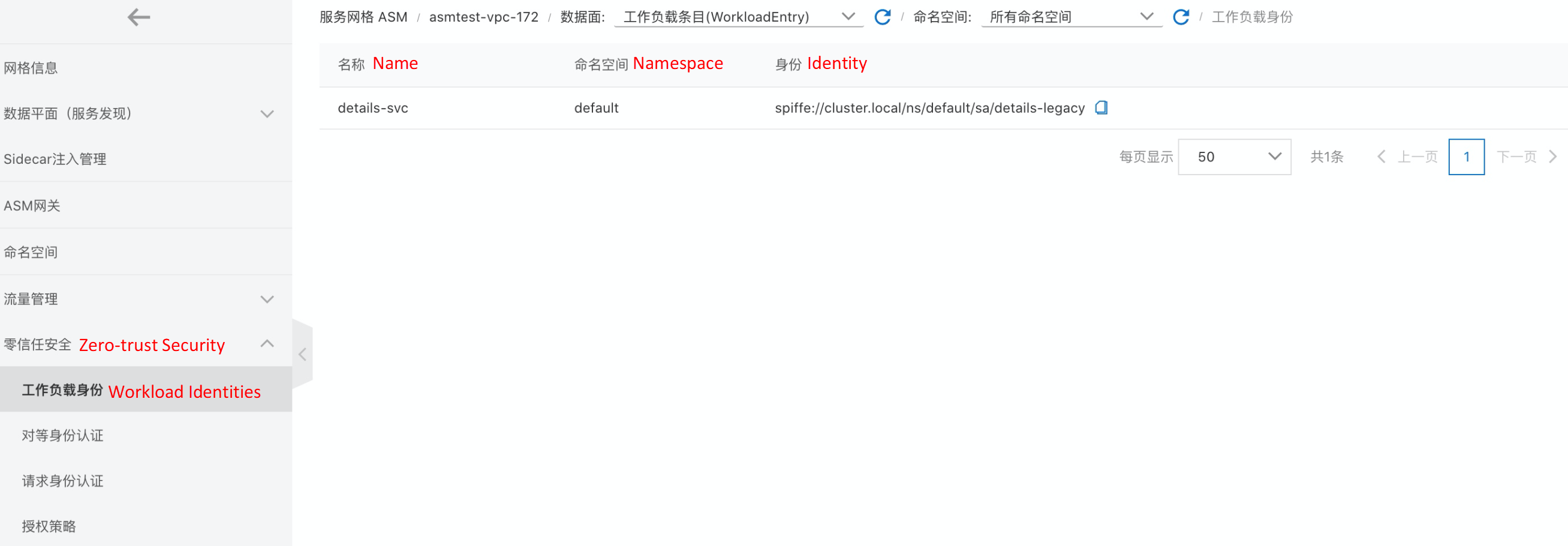
Authentication refers to identity. What is this service? Who is this end user? Can I believe they are the same as what they say?
ASM provides two types of authentication:
Follow the Getting Started guide to install and deploy the bookinfo example.
First, when trying to access the details service using pure-HTTP from a productpage pod in the same namespace (for example, default in this example), the request should be returned in the status 200 by default because both TLS and plain text traffic can be accepted by default.
kubectl exec $(kubectl get pod -l app=productpage -o jsonpath={.items..metadata.name}) -c istio-proxy -- curl http://details:9080/details/1 -o /dev/null -s -w '%{http_code}\n'Next, define peer authentication under the namespace default.
In the ASM console, open the corresponding ASM instance. In the left-side navigation pane, you can view the following peer authentication under zero-trust security. On the right-side page, click Create Two-way mTLS Mode* to define the mTLS mode as STRICT for workload details.
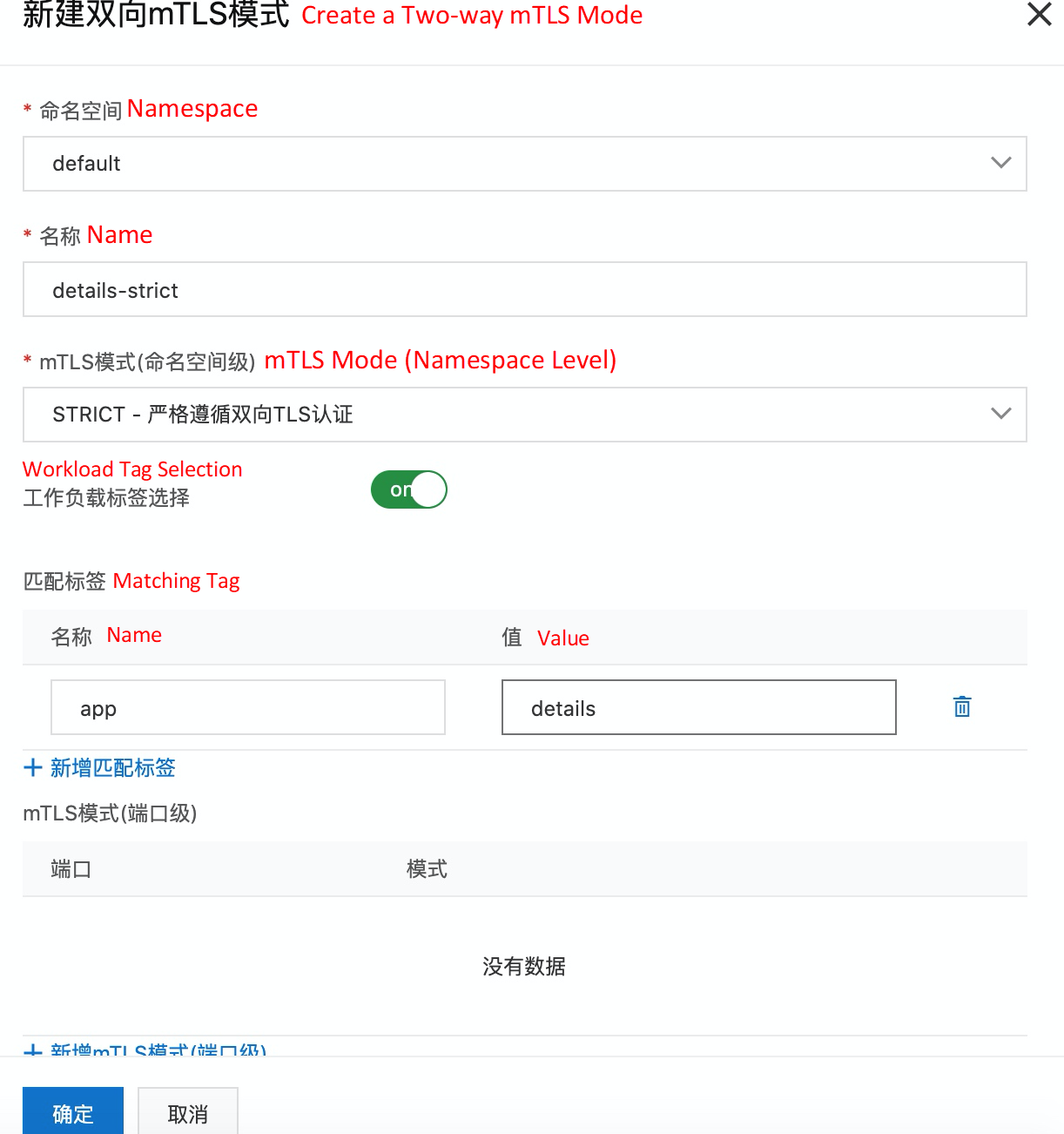
Use pure-HTTP with productpage pod to access the details service:
kubectl exec $(kubectl get pod -l app=productpage -o jsonpath={.items..metadata.name}) -c istio-proxy -- curl http://details:9080/details/1 -o /dev/null -s -w '%{http_code}\n'
000
command terminated with exit code 56The exit code 56 indicates that the network data failed to be received. This is as expected. Workload details define the mTLS mode as STRICT, so TLS certificate authentication is required in each request.
To allow normal access, you can change from STRICT to PERMISSIVE through the peer authentication defined above. The corresponding YAML definition is listed below:
apiVersion: security.istio.io/v1beta1
kind: PeerAuthentication
metadata:
name: details-strict
namespace: default
spec:
mtls:
mode: PERMISSIVE
selector:
matchLabels:
app: detailsFirst, we will create a request authentication policy to enforce JWT authentication for inbound requests from the details service. In the ASM console, open the corresponding ASM instance. In the left-side navigation pane, you can view the following request authentication under zero-trust security. On the right page, click the Create button to define JWT rules for workload details.
The issuer value is set to testing@secure.istio.io,
The value of jwks is taken from the https://raw.githubusercontent.com/istio/istio/release-1.9/security/tools/jwt/samples/jwks.json:
{ "keys":[ {"e":"AQAB","kid":"DHFbpoIUqrY8t2zpA2qXfCmr5VO5ZEr4RzHU_-envvQ","kty":"RSA","n":"xAE7eB6qugXyCAG3yhh7pkDkT65pHymX-P7KfIupjf59vsdo91bSP9C8H07pSAGQO1MV_xFj9VswgsCg4R6otmg5PV2He95lZdHtOcU5DXIg_pbhLdKXbi66GlVeK6ABZOUW3WYtnNHD-91gVuoeJT_DwtGGcp4ignkgXfkiEm4sw-4sfb4qdt5oLbyVpmW6x9cfa7vs2WTfURiCrBoUqgBo_-4WTiULmmHSGZHOjzwa8WtrtOQGsAFjIbno85jp6MnGGGZPYZbDAa_b3y5u-YpW7ypZrvD8BgtKVjgtQgZhLAGezMt0ua3DRrWnKqTZ0BJ_EyxOGuHJrLsn00fnMQ"}]}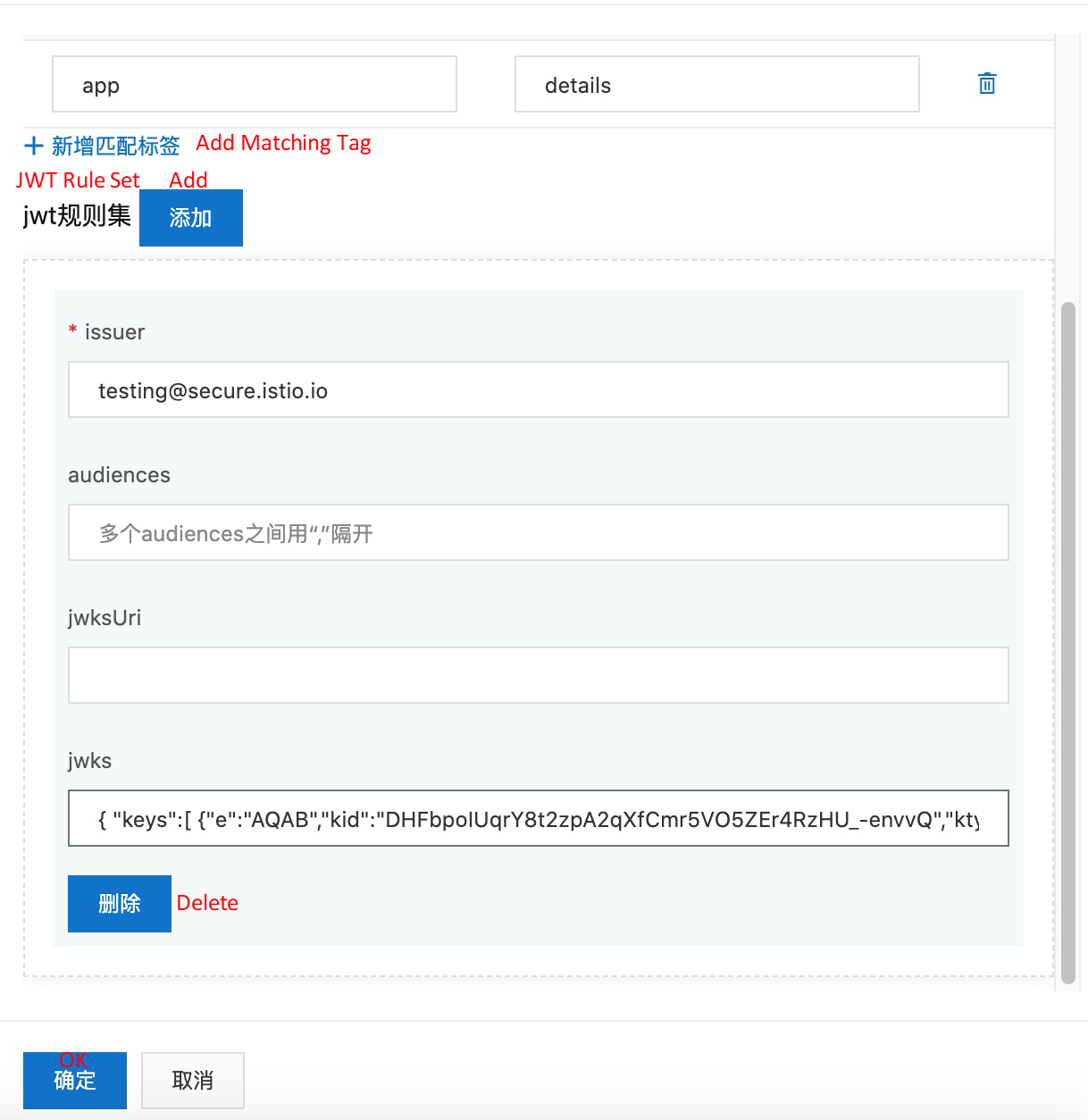
Then, when you try to use pure-HTTP in the productpage pod to access the details service, you can see that the returned result is 200.
Set the TOKEN value of the variable to:
export TOKEN=eyJhbGciOiJSUzI1NiIsImtpZCI6IkRIRmJwb0lVcXJZOHQyenBBMnFYZkNtcjVWTzVaRXI0UnpIVV8tZW52dlEiLCJ0eXAiOiJKV1QifQ.eyJleHAiOjQ2ODU5ODk3MDAsImZvbyI6ImJhciIsImlhdCI6MTUzMjM4OTcwMCwiaXNzIjoidGVzdGluZ0BzZWN1cmUuaXN0aW8uaW8iLCJzdWIiOiJ0ZXN0aW5nQHNlY3VyZS5pc3Rpby5pbyJ9.CfNnxWP2tcnR9q0vxyxweaF3ovQYHYZl82hAUsn21bwQd9zP7c-LS9qd_vpdLG4Tn1A15NxfCjp5f7QNBUo-KC9PJqYpgGbaXhaGx7bEdFWjcwv3nZzvc7M__ZpaCERdwU7igUmJqYGBYQ51vr2njU9ZimyKkfDe3axcyiBZde7G6dabliUosJvvKOPcKIWPccCgefSj_GNfwIip3-SsFdlR7BtbVUcqR-yv-XOxJ3Uc1MI0tz3uMiiZcyPV7sNCU4KRnemRIMHVOfuvHsU60_GhGbiSFzgPTAa9WTltbnarTbxudb_YEOx12JiwYToeX0DCPb43W1tzIBxgm8NxUg
kubectl exec $(kubectl get pod -l app=productpage -o jsonpath={.items..metadata.name}) -c istio-proxy -- curl http://details:9080/details/1 -o /dev/null --header "Authorization: Bearer $TOKEN" -s -w '%{http_code}\n'
200If an invalid token is passed, we should see a "401: Unauthorized" response:
kubectl exec $(kubectl get pod -l app=productpage -o jsonpath={.items..metadata.name}) -c istio-proxy -- curl http://details:9080/details/1 -o /dev/null --header "Authorization: Bearer badtoken" -s -w '%{http_code}\n'
401However, if we don't pass tokens at all, RequestAuthentication doesn't invoke the policy. Requests that do not use JWT tokens also return 200.
kubectl exec $(kubectl get pod -l app=productpage -o jsonpath={.items..metadata.name}) -c istio-proxy -- curl http://details:9080/details/1 -o /dev/null -s -w '%{http_code}\n'
200Therefore, in addition to this authentication policy, we need an authorization policy that requires JWT for all requests. The next section describes how to define authorization policies in ASM.
ASM provides authorization policies. You can use AuthorizationPolicy resources to activate the authorization mechanism between microservices and use the following content to establish an appropriate traffic authorization policy mechanism:
from field in rules specifies the source of the request.to field in rules specifies the requested operation.when field specifies other conditions that need to be met to apply the rule.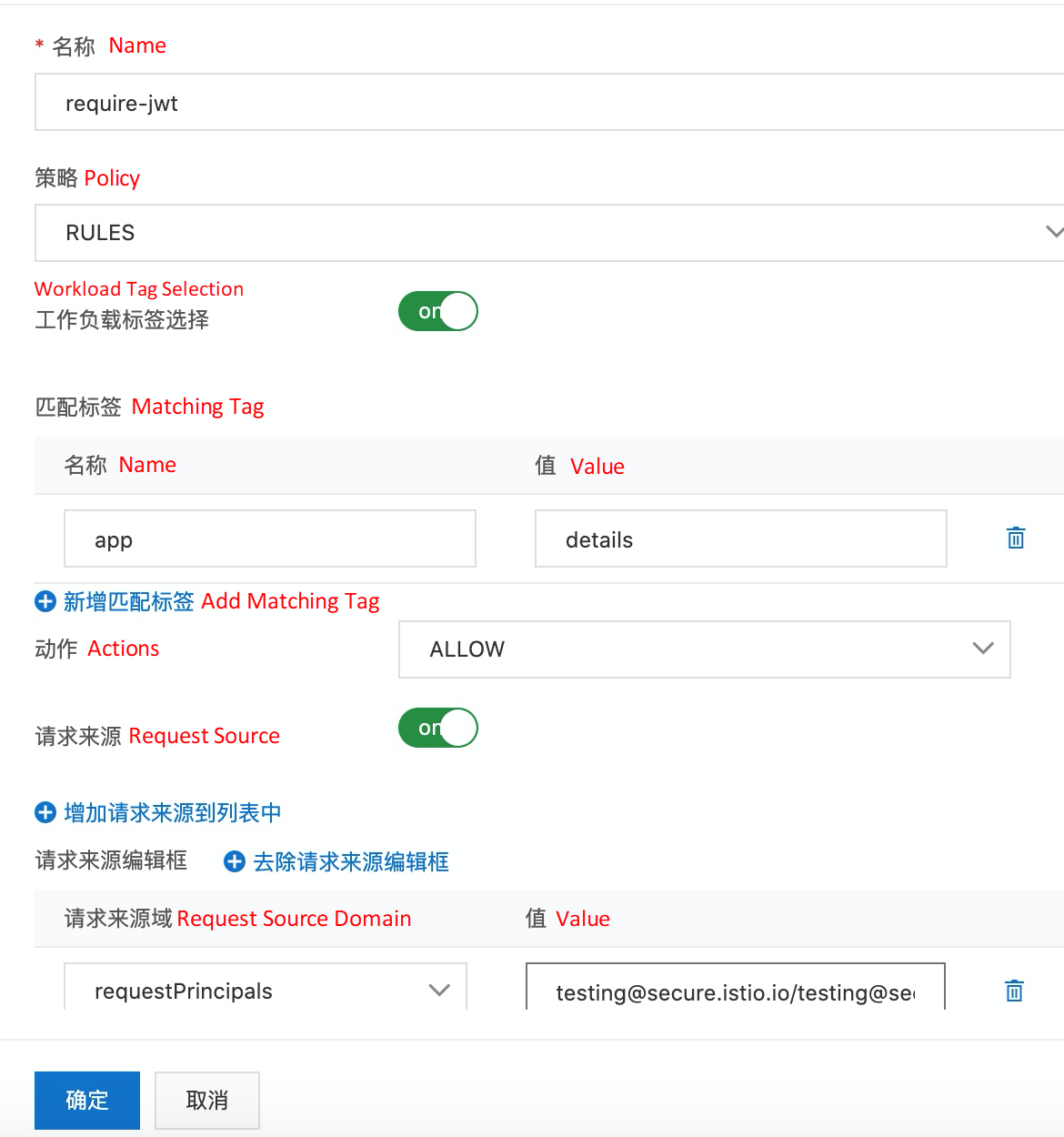
The corresponding YAML definition is listed below:
apiVersion: security.istio.io/v1beta1
kind: AuthorizationPolicy
metadata:
name: require-jwt
namespace: default
spec:
action: ALLOW
rules:
- from:
- source:
requestPrincipals:
- testing@secure.istio.io/testing@secure.istio.io
selector:
matchLabels:
app: detailsAgain, if you do not use JWT Token to send requests, you should now see 403 - Forbidden. This is the case when AuthorizationPolicy takes effect. All frontend requests must have a JWT Token.
kubectl exec $(kubectl get pod -l app=productpage -o jsonpath={.items..metadata.name}) -c istio-proxy -- curl http://details:9080/details/1 -o /dev/null -s -w '%{http_code}\n'
403OPA is a graduated project of the Cloud Native Computing Foundation (CNCF). As a policy engine, OPA can be used to implement fine-grained access control on your applications. You can deploy OPA as a standalone service along with microservices. If you want to protect an application, make sure each request for a microservice is authorized before the request is processed. The microservice makes an API call to OPA to decide whether the request is authorized.
ASM integrates with the OPA plugin. You can use OPA to define access control policies to implement fine-grained access control on your applications. It supports dynamic OPA policy updates.
Please refer to this link for details.
In summary, ASM offers the following components to enhance security:
Each workload establishes an identity through an X509 TLS certificate, which is used by each Sidecar agent. ASM provides and periodically rotates the certificate and private key. If a particular private key is stolen, service mesh will replace it with a new private key to reduce the attacks.
1. Use authorization policies to implement IP-based RAM on the ingress gateway (please see this link) or RAM based on custom external authorization. The following figure shows the implementation of ASM-based gateway authorization policies for a cloud product.
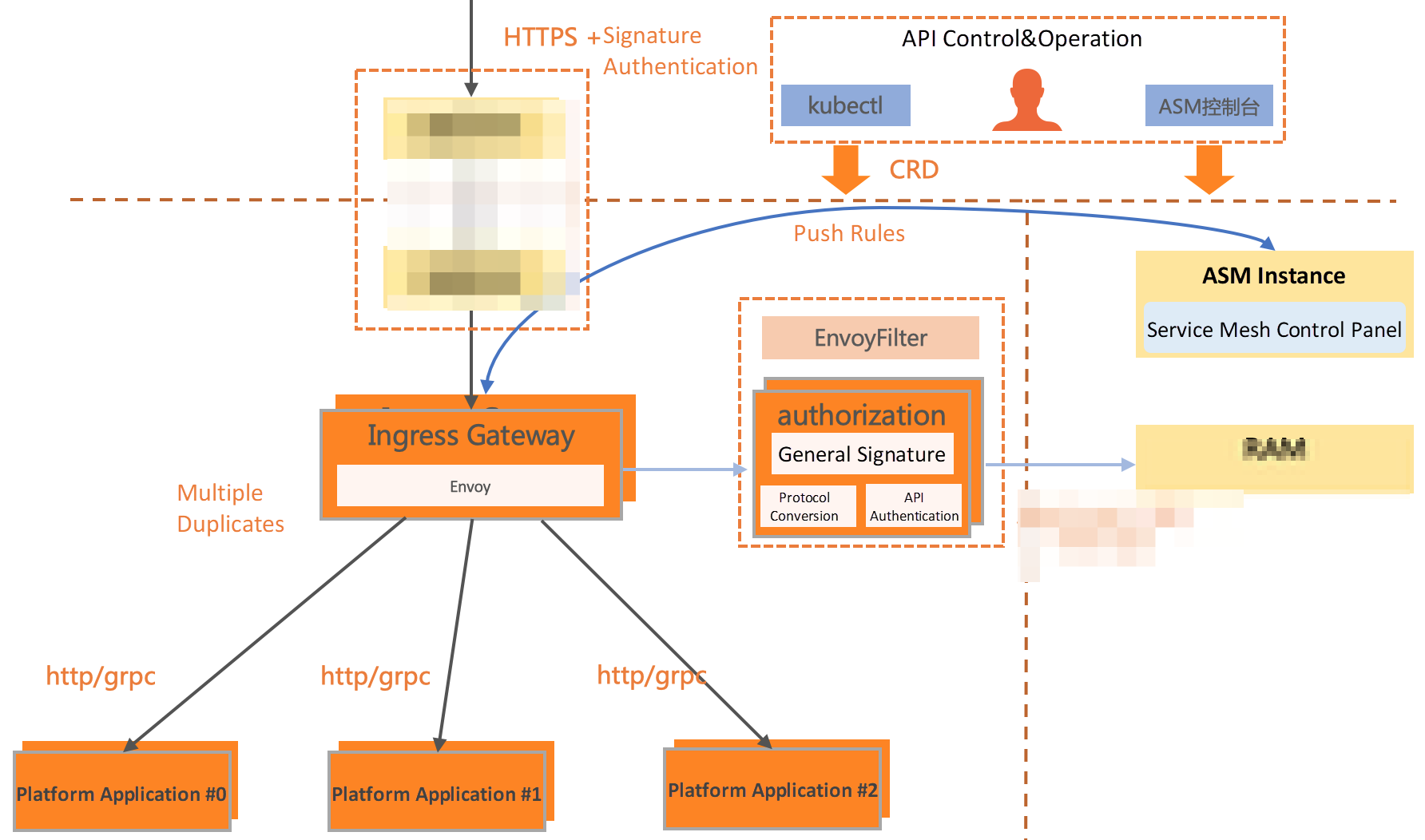
2. An internet finance customer uses the authorization policy provided by ASM to isolate outbound regions and application regions in terms of access control for cross-cluster multi-language applications. At the same time, it can be combined with the egress gateway to audit the mesh traffic. With the authorization policy, it can also control the access permissions of applications to third-party services.
Alibaba Cloud's "Big Computing Power" Speeds Up Inceptio's Autonomous Driving Simulation by 20!
The Seamless Transition from Traditional Microservice Frameworks to ASM

206 posts | 12 followers
FollowAlibaba Cloud Community - May 19, 2022
Alibaba Clouder - February 22, 2021
Xi Ning Wang(王夕宁) - July 21, 2023
Alibaba Clouder - February 22, 2021
Alibaba Cloud Native - November 3, 2022
Alibaba Cloud Native Community - December 18, 2023

206 posts | 12 followers
Follow Container Service for Kubernetes
Container Service for Kubernetes
Alibaba Cloud Container Service for Kubernetes is a fully managed cloud container management service that supports native Kubernetes and integrates with other Alibaba Cloud products.
Learn More Microservices Engine (MSE)
Microservices Engine (MSE)
MSE provides a fully managed registration and configuration center, and gateway and microservices governance capabilities.
Learn More Security Solution
Security Solution
Alibaba Cloud is committed to safeguarding the cloud security for every business.
Learn More Security Overview
Security Overview
Simple, secure, and intelligent services.
Learn MoreMore Posts by Alibaba Cloud Native
Dikky Ryan Pratama May 30, 2023 at 2:53 am
awesome!